habitat rupestre.pdf - Società Friulana di Archeologia
habitat rupestre.pdf - Società Friulana di Archeologia
habitat rupestre.pdf - Società Friulana di Archeologia
Create successful ePaper yourself
Turn your PDF publications into a flip-book with our unique Google optimized e-Paper software.
CLASSIFICATION OF RUPESTRIAN SETTLEMENTSR. CapraraArcheogruppo “E. Jacovelli” Massafra, Taranto, Italia1. Natural cavesPrehistoric caves are the most ancient art places. The earlytraces of communication and expression can be found in theslow and continuous environmental mo<strong>di</strong>fication process duringthe Palaeolithic era (650000 to 170000 b.C.) by the earlysmall human communities living in cavern, caves, and rupestrianshelters.Living in a cave and spen<strong>di</strong>ng there the harsh winters of glacialperiods was not only a way to take shelter from a riskyenvironment. It also meant the mo<strong>di</strong>fication of the cave forthe primary needs of human life. These dark, shapeless andprotective ambiences were painted, carved, made more accommodating.They lost their natural connotation; humanintervention made them artificial, so they represent a sort ofpre-architecture. Palaeolithic Caves are special places, as theyare places which bear the early signs of the presence of man;they testify the most ancient artistic and cultural expressions.They are the archetype of architecture, the beginning, the origin.Their historic, scientific and artistic value is very high.They are mostly in Europe, especially in France and in Cantabria.The most famous Spanish caves are in El Castillo andAltamira; the most famous French caves are in Lascaux.There are many prehistoric caves in Italy too, with <strong>di</strong>fferentcharacteristics and ages, all along the peninsula. Examplescan be found in the Karst alps (Trieste) and in the Balzi Rossi(Liguria) in Northern Italy, on the Mount Circeo (Lazio) andthe Tyrrhenian coast in Central Italy. Many caves can be foun<strong>di</strong>n Southern Italy: near the Fucine Lake (Avezzano, Abruzzo)and Salerno (Campania), close to Matera (Basilicata) and inGargano and Murgia (Puglia). There are prehistoric caves alsoin the islands: near Palermo, Siracusa (Sicily), in the Aega<strong>di</strong>anIslands and in Sar<strong>di</strong>nia, where two caves have been investigate<strong>di</strong>n the territory of Mara. This investigation has provedthat some of the Sar<strong>di</strong>nian caves were sanctuaries, other wereplaces of living. The two caves are close to the Sanctuary ofN.S. <strong>di</strong> Bonu Ighinu: in the same territory there’s the cavecalled Sa ucca ‘e su tintirriolu (the bat’s mouth). The BonuIghinu culture developed between the 4000 and the 3500 b. C.:its name is linked to the fin<strong>di</strong>ngs of several ceramic artefactswith great artistic value, bone tools and idols in 1969. Duringthese earl excavations, some human bones were found in theanterior part of the cave, which is more than 2 kilometres long.Following stu<strong>di</strong>es have shown that the cave was a sanctuaryand a necropolis. The Filiestru cave is 350 meters downhill:it was investigated in 1979, and older stratifications (4750 to4500 b. C.) were found. The archaeological finds were everydayobjects, tools, debris: this showed that the cave was aliving place.During the Classical Antiquity, many of caves were sanctuariesof healing gods, and they have been Christianized in theLate Antiquity. So they have been generally de<strong>di</strong>cated to Michaelthe Archangel, especially in Puglia and Campania. TheApparition Cave on the Gargano is an example: the Lombardsturned it into a national sanctuary and it became one of thefour pilgrimage destinations for Christians in the Middle Age.2. Rock sheltersRock shelters are natural cave-like wide but not deep openings.They are caused by the exfoliation or the erosion of therock on a cliff. Humans left behind debris, tools, and otherartefacts in the shelters, as in the Manisi shelter (in the Ravineof Palagianello, Taranto), where a stone industry of the MiddlePalaeolithic Age was found. There are tracks of Palaeolithiclife in many of the shelters which have been investigate<strong>di</strong>n Italy. Valtorta is the most known Mesolithic cult place inSpain: many wall paintings and graffiti with humans and animalswere found in its 120 rock shelters. These are at a heightbetween 800 and 1000 meters, and they are mostly <strong>di</strong>ffused inthe east, from the Pyrenees to Andalusia. Rock shelters wereoften adapted to permanent living places through the buil<strong>di</strong>ngof dry stone walls to <strong>di</strong>vide the space. In the last centuries,rock shelters have been used for livestock, so their name mayrefer to this activity: for example, they are called “caprili”(goat shelters).Fig. 1 Troglodyte village, Rivolta ravine, Ginosa (TA).41volumeRicerca_OK_2012-11-15.indd 41 16/11/2012 15:00:57
















